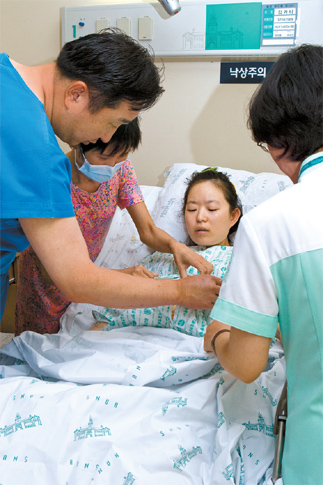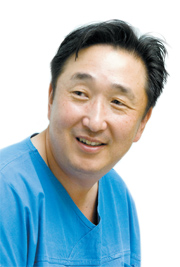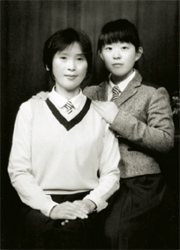Mom’s operation ends up saving daughter’s life

Seo Kyung-seok (left), of Seoul National University Hospital, checks on Kim after her surgery. [JoongAng Ilbo]
Bang Cha-young, 47, was about to give up on her 20-year battle against liver cirrhosis.
Her condition had become cancerous, and her doctor had warned that her only realistic shot at survival was a liver transplant.
Otherwise, she would have less than a year left to live.
But as a low-income single mother collecting welfare checks, she couldn’t begin to fathom how she could cover the 30 million won ($26,880) to 40 million won medical fees needed for the procedure.
And more to the point, how was Bang going to tell her 18-year-old daughter Kim Ga-yi, a high school senior, that she needed part of her liver to survive?
The liver, the body’s largest internal organ, is one of the few human organs that is capable of natural regeneration on its own. As little as 25 percent of the liver can regenerate to a complete liver over time.
So far in 2008, Seoul National University Hospital has carried out 28 liver transplants between family members.
Liver or kidney transplants between families members often make the news, but Bang’s story is unusual.

Bang Cha-young (left) hugs her daughter, Kim Ga-yi, after the operation to remove Kim’s ovarian tumor.
Her liver transplant saved the life of her daughter, the donor.
Back at the community center, Bang spoke to Cho Shin-young, a 35-year-old social worker.
“Do you know where I can get some medical attention and eventually die in peace?” Bang asked, aware of the severity of her medical condition. At this stage she said she wasn’t really looking for medical treatment, just a quiet place to prepare for death.
Bang began to sob, she recalled, when she mentioned she had an 18-year-old daughter.
Cho told the distressed Bang to try not to worry too much and that there would be a solution.
The social worker said she immediately thought back to when she helped a patient in a similar predicament.

Seo Kyung-seok of Seoul National University Hospital. [JoongAng Ilbo]
To get support to help cover Bang’s crippling hospital expenses, Cho gathered documents and a summary of Bang’s story and submitted them to Korea Welfare Foundation, a nongovernmental organization that works for people in need and has teamed up with Love Request in the past.
Cho received positive feedback from Korea Welfare Foundation, but time was not on Bang’s side and the organization said it needed time to process the necessary documents.
Cho told Bang to proceed with the operation first and worry about the funding later.
To carry on, Bang was given emergency funds worth 3.5 million won from the district office where she lived in Daejeon.

Social worker Cho Shin-young
With the operation day looming, time was running out and Cho had still not heard back from the Korea Welfare Foundation.
Then, 10 days prior to the transplant, the foundation finally approved a 20 million won grant to cover Bang’s hospital expenses.
While the cost of the operation was a monumental hurdle for the financially strapped Bang, the actual commitment from her daughter was essential.
What if she refused to donate the vital tissues that her mother so urgently needed?

Bang Cha-young and Kim Ga-yi
“O.K., Mom. But let’s try to get this done quickly over the winter break before I become a senior,” Kim had said, with an eye on the need to stay on top of her studies.
The 18-year-old said she vaguely remembered one of her elementary school teachers speaking about the ability of the liver to naturally regenerate. This helped her to understand what her mother needed to do, she said.
A few days prior to the operation in Seoul, the mother and daughter visited a photo studio. They had not had any family photos taken since Bang’s divorce in 1998. The cost was prohibitive to this two-member family.
But with the uncertainty of the operation looming, this seemed like an opportune time to get their portraits taken.
After all, no one could be sure how the operations would play out.
The doctor in charge of the operation, Seo Kyung-seok of Seoul National University Hospital, decided on a new procedure that would minimize the physical scarring on the daughter.
The operation got under way at 8 a.m. on Jan. 21. Kim was taken into the operation room first; Bang was taken into the operation room at around 11 a.m. Securing Kim’s liver took eight hours and 25 minutes; putting the donor portion of the liver into Bang’s body took an additional 10 hours and 45 minutes. The entire operation was completed well past midnight.
On the day the story about the mother and daughter aired on the Love Request program, which was Feb. 2, Kim was released from the hospital in healthy condition.
That could have been the end of the story, and to most of the participants, it was.
But approximately seven months later, Kim was recovering from an operation of a different kind.
In March 2008, while reviewing the state of Kim’s liver in a routine post-op procedure, the doctors discovered something that wasn’t right. It looked like Kim had a potentially lethal tumor in one of her ovaries.
The discovery was as shocking as it was fortuitous. If Kim had not decided to donate her liver to her mother, medical staff may not have known about the growth until it was too late.
“Since we were able to discover the tumor at a relatively early stage, we were able to extract it before the fatal scenario of her ovary and a Fallopian tube getting tangled up,” said Jung Hyun-hoon of the obstetrics and gynecology department at the Seoul National University Hospital, where Kim was admitted.
“The tumor was sizable, at over 9 centimeters [3.54 inches], but we successfully removed it,” added Jung.
The liver transplant and the removal of the ovarian tumor were major operations, but there is a more pressing matter on Kim’s mind these days. She’s worried about the tests coming up at school, and we all know how crucial tests are for high school seniors in Korea.
She said she hasn’t forgotten the operation, or that her mom was so sick or that she herself had a brush with mortality.
“I knew when the time came that I would be there for my mom,” she said, turning back to her books.
By Kim Jung-soo JoongAng Ilbo/ Jason Kim Staff Reporter [jason@joongang.co.kr]










with the Korea JoongAng Daily
To write comments, please log in to one of the accounts.
Standards Board Policy (0/250자)